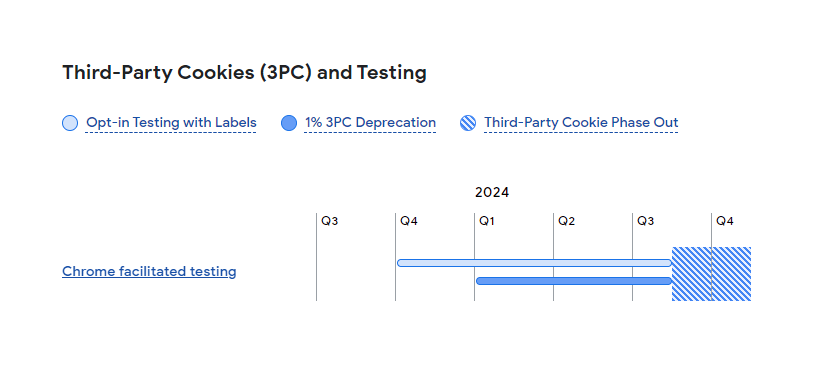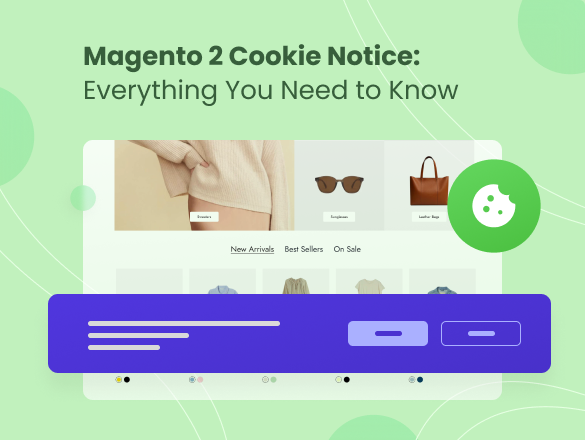Privacy Sandbox: Is Your Business Ready for Google Chrome Changes?
Data privacy has been a great concern for Internet users in recent years. Among the myriad of worries, targeted advertising and cross-site tracking have gained significant attention. You must have noticed at least once that if you click on a product through an ad, similar product ads start following you everywhere on the web. This practice not only intrudes on individual privacy but also raises questions about the ethical boundaries of online advertising.
Indeed, the technology that websites are using for targeted advertising is now being used far beyond the initial intent, not meeting user expectations of data privacy.
To address this concern, the tech giant initiated Google Privacy Sandbox – a set of standards to enhance user privacy on the web. This aims to provide both users with a safer environment and businesses with alternative tools to third-party cookies and cross-site tracking.
In this blog, we will delve into what Chrome Privacy Sandbox is, why Google is implementing it, and what it means for online businesses. Plus, we will provide steps that each online business should follow to get ready for the Google Chrome changes ahead.
What is Google Privacy Sandbox?
The Privacy Sandbox is a Google initiative aimed at enhancing user privacy while still enabling personalized advertising and measurement on the web.
Specifically, it’s a set of privacy-focused web standards and APIs that, among other things, are designed to replace the functionality of third-party cookies, which have long been used for tracking and targeting users across the web. The Privacy Sandbox initiative aims at two things:
Phasing out third-party cookies.
These cookies, placed by websites other than the one you’re visiting, track your browsing activity across the web, raising privacy concerns.
Offering privacy-preserving alternatives.
The Sandbox seeks to create new tools that allow relevant advertising and website functionality without compromising user privacy.
Why Privacy Sandbox is More Secure
Most websites today use third-party cookies to track user activity. They are placed on user devices by different advertisers and tracking companies and collect data about user’s browsing activity.
Instead, Google Privacy Sandbox aims to provide more control over the advertising ecosystem and privacy by:
- Limiting cross-site tracking: This makes it more difficult for individuals to be tracked across different websites, reducing the potential for misuse of personal data.
- Enhancing user control: Users will have greater control over their data and how it’s used, fostering trust and transparency.
- Promoting a more secure ecosystem: By minimizing reliance on third-party cookies, the Sandbox aims to reduce the vulnerability to security breaches and data leaks.
Let’s see in detail how user information is collected and stored in targeted advertising using Privacy Sandbox and traditional cookie technologies:
| Third-Party Cookies | Privacy Sandbox | |
| Data Storage | User data is stored in third-party cookies on servers controlled by advertisers or third-party tracking companies | User data is stored locally on the user’s device (is kept within the browser and is not shared with third parties) |
| Identification Method | Unique identifiers (cookies) track individual users across the web, building detailed profiles of users’ browsing habits | Federated Learning of Cohorts (FLoC): Users are grouped into advertising “topics” (interests) based on similar browsing habits |
| Granularity | Individual cookies track specific user behavior with a high level of granularity | Cohorts are groups of users with similar interests, providing anonymity and privacy protection for individual users |
| User Tracking | Individual user behavior is tracked across websites (advertisers can build detailed profiles for targeted advertising and potentially intrusive practices) | Aggregated user data within cohorts is used for targeting ads (advertisers do not have access to individual user data and can only target ads based on broader audience characteristics) |
| User Transparency | Users can block third-party cookies on each website they visit, sometimes being unaware of the extent of tracking | Users can choose not to participate in cohort-based advertising and opt out of tracking entirely in Chorme’s settings. |
In a nutshell, Google aims to enhance user privacy by tracking your web browsing history and categorizing you into groups (“Tech Gadgets”, “Beauty Products”, etc.) based on your interests. This eliminates tracking individual user behavior across sites and sharing these detailed profiles with third parties.
These new measurement and tracking algorithms aim to provide more privacy and control over personal data that is being collected about users.
Why Google Is Phasing Out Third-Party Cookies
There are several factors that prompted Google to enhance user privacy on the web and, therefore, implement the Google Privacy Sandbox.
Privacy Concerns
The major factor is the growing concern about online privacy and personal data protection. More and more data protection laws and regulations have emerged over the last decade in response to the consumer demand for online privacy. So Google offers the Privacy Sandbox as a way to address these concerns while still supporting the digital advertising ecosystem.
Regulatory Landscape
The regulatory landscape surrounding online privacy has undergone significant evolution in response to growing concerns about data protection. While initiatives like the Cookie regulation enable users to restrict cookie placement, not all websites implement effective cookie notices, which leads to cross-site tracking. As a result, cookies collect users’ personal information that is owned by third parties.
Evolving regulations like GDPR (General Data Protection Regulation) and CCPA (California Consumer Privacy Act) impose stricter limitations on data collection and usage, necessitating adaptation.
The Need to Adapt
In recent years, the third-party cookie phase-out was prompted by the initiative of the major web browsers like Safari and Firefox that restricted the use of cookies and cut down on cross-site tracking. Although they have taken steps to restrict or remove existing mechanisms, such as third-party cookies, they didn’t provide effective alternatives that would allow advertisers to maintain functionality while prioritizing privacy.
What Does It Mean for Businesses?
The transition to the Privacy Sandbox brings both challenges and opportunities for businesses. On the one hand, the deprecation of third-party cookies may affect third-party functionality on your store and user experience, necessitating businesses to adapt to new technologies. On the other, resecting user concerns and moving towards new privacy-centric technologies lead to more transparency and trust.
Challenges
Firstly, businesses may already be experiencing revenue loss, as Chrome has initiated testing by restricting third-party cookies for 1% of users as of January 2024. With a total number of 3.22 billion Chrome users, a seemingly modest 1% represents a significant portion of potential customers whose browsers don’t support third-party cookies.
During the cookie phaseout tests on our clients’ websites, we noticed the following most common functionality disruptions:
- Social logins. Websites using a Facebook login, Google One Tap login, LinkedIn login, or other social logins relying on third-party cookies may encounter disruptions when disabling them.
- Payment services. Some payment services, such as Amazon and PayPal, use third-party cookies for fraud detection and may need some adjustments.
- Advertising & analytics systems dependent on third-party cookies may malfunction, impacting targeted campaigns and data analysis.
Moreover, with Google’s plan to fully deprecate third-party cookies by the end of Q4 2024, businesses must accelerate their adoption of the emerging Privacy Sandbox technologies to remain competitive and compliant with evolving privacy standards.
Opportunities
Despite the challenges posed by the Privacy Sandbox, businesses have the opportunity to adopt new, privacy-centric approaches and thrive in the digital ecosystem.
The main advantage is compliance with evolving privacy regulations. With the emergence of CCPA (California Consumer Privacy Act) and GDPR (General Data Protection Regulation) in Europe, data privacy regulations become stricter worldwide. Adopting Privacy Sandbox tools can help businesses stay compliant and avoid hefty fines. Additionally, Privacy Sandbox aims to provide solutions that respect user privacy while still allowing businesses to function effectively.
Moreover, demonstrating a commitment to user privacy can be a valuable differentiator for businesses, building trust and user loyalty. By adopting Privacy Sandbox technologies, businesses can show their customers that they respect their privacy and data, potentially leading to increased trust and loyalty.
So, the early adoption of Privacy Sandbox technologies can provide a competitive advantage by enabling businesses to stay ahead of regulatory changes and technological developments. This can attract customers who prioritize privacy and data protection when choosing products and services.
Google Privacy Sandbox Timeline: When to Be Ready
Google announced the Privacy Sandbox initiative back in August 2019.
In January 2024, Chrome restricted third-party cookies for 1% of users to facilitate testing and gradually rolling out, they plan to finish it in Q3. The full deprecation of third-party cookies is planned by the end of Q4.

This means that from the start of 2024, you can expect to see an increase in the number of Chrome users on your site who have third-party cookies disabled. Consequently, you should adapt to these changes as soon as possible.
The testing period continues through to Q3 2024, and by Q4, Google plans to disable third-party cookies for all Chrome users.
Plumrocket Partners with Google to Help Businesses Prepare
We are actively working with the Google team on third-party cookie issues on Magneto sites, and therefore we have launched a Third-Party Cookie Phaseout Audit service to help our clients prepare for the upcoming changes. The audit includes:
- Breakage Test: We’ll conduct a comprehensive assessment to identify any functionality issues that may arise when third-party cookies are disabled. This ensures that your website continues to function smoothly and provides a seamless user experience.
- Core Functionality Testing: We’ll verify that essential features of your website, such as login systems, shopping carts, and user preferences, work seamlessly without relying on third-party cookies.
- Third-Party Service Analysis: We’ll assess the impact of the Privacy Sandbox on any third-party services integrated into your website, such as analytics platforms, advertising networks, and social media widgets.
- Detailed Report: Finally, we’ll provide you with a comprehensive report summarizing the results of the audit and offering recommendations for mitigating any potential issues.
By leveraging our Third-Party Cookie Phaseout Audit service, businesses can proactively prepare for the transition to the Privacy Sandbox technologies, ensuring continued functionality, compliance, and performance in the evolving digital landscape.
Future-proof your website functionality and make sure your website is ready with our Third-Party Cookie Phaseout Audit service.
.




